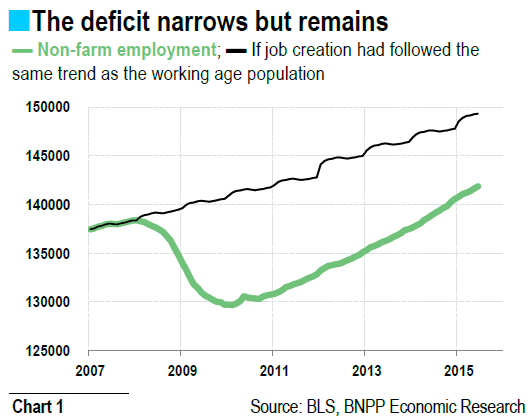■ In June, the employment report once again showed a mixed picture.
■ Job creation remains strong and the unemployment rate is at its lowest for seven years. But the labour force participation rate fell and payroll slowed.
■ The improvement in employment, from which many Americans remain excluded, remains only partial. Although the jobs destroyed in the recession have now been replaced, the additional jobs that failed to be added at that time have yet to feed through.
■ This is weighing on consumer sentiment and purchasing power, thus limiting the rate of growth and inflation.
Because Independence Day falls on a Saturday this year, Friday 3 July was a public holiday in the USA, and the June employment report was therefore published on Thursday. The most eagerly awaited figures, namely job creation and the unemployment rate, were once again highly positive, with 223,000 jobs created and unemployment dropping to 5.3%, its lowest level since April 2008.
However, the overall picture continues to show a slow reduction in the under-utilisation of labour. Our SLACK Index, which illustrates under-employment, has been virtually flat since the beginning of the year, and for it to fall in May and June will need a very positive JOLTS report with the hire rate recovering to 3.7% (3.5% in April) and a quit rate of 2% (1.9% in April).
Since the beginning of the year, the labour force participation rate had stabilised, slightly above its record lows. It however fell sharply in June, to 62.6%, 0.2 percentage point below its average for January to May. At the same time, wage growth is still showing no signs of acceleration. Growth in hourly earnings for non-supervisory production workers slipped back below 2% y/y in the private sector.
Even the good news wasn’t as good as all that. Although job creation in June was respectable, it fell below the consensus expectation of 233,000.
Historically, June figures tend to be revised down over subsequent months (by an average of 36,000). On top of that, the figures for the two previous months saw just such a downgrade, totalling 60,000. Lastly, the fall in the unemployment rate resulted entirely from the shrinking of the labour force, with employment, as measured by the household survey, falling 56,000 in June. Thus the whole of the fall in the unemployment rate, from 5.5% to 5.3%, can be explained by the fall in the labour force participation rate. However, it should be noted that the household survey might under estimate the employment situation in June, as the reference week came one week earlier in the month than usual. In short, one should not celebrate some figures too much, nor be too concerned by others.

estimate the employment situation in June, as the reference week came one week earlier in the month than usual. In short, one should not celebrate some figures too much, nor be too concerned by others.
For all that employment has been dynamic over recent months, it has still not got back to the level it would have had but for the recession. If, since January 2007, non-farm employment had risen so as to absorb all new entrants to the working age population, there would be around 7.5 million more jobs than there currently are. The government sector has been a great contributor to this job deficit, in the vicinity of 1.8 million jobs.
Although the unemployment rate has fallen from 10% in October 2009 to 5.3% currently, much of this is due to millions of people leaving the labour force. By way of comparison, the US population has grown by 14 million since October 2009, with the labour force up by only 3.2 million. Whilst demographic movements explain some of this trend, much of it is down to the labour force participation rate of people aged between 25 and 54: this stood at 82.6% in October 2009, but had fallen to 80.6% by June 2015.
This goes a long way to explaining why consumers remain cautious, as reflected in the consumer confidence index published by the Conference Board, and particularly the assessment of current job market conditions. The long-term relationship between the unemployment rate and this indicator would suggest that the latter should be nearly 13 points above its current level. Although the unemployment rate is close to its estimated equilibrium level, the situation is not sufficiently satisfactory to support consumer confidence, particularly as wages are not accelerating, thus limiting growth in purchasing power.
by Alexandra ESTIOT
